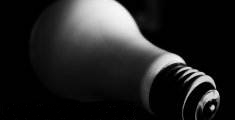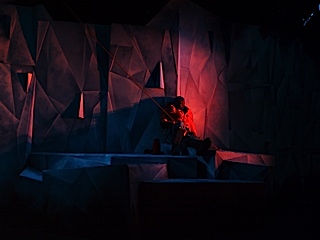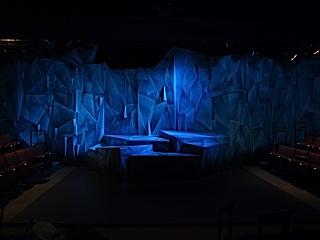

K2
Performance Network Theatre
Directed by Tim Rhoze
Scenic Design: Daniel Walker
Scenic Painting: Janine Woods Thoma
Lighting and Sound Design: Andrew J. Hungerford
The Concept
This production of K2 started with the idea that we would not be able to literally create the mountainside for an audience seated mere feet from the performers. The set was a stylized mountain, with an abstract expressionist paint treatment. It then fell to the sound and lighting to be evocative of the environment, to help support the audience in feeling like they were high up with the the two climbers.
To that end, the basis for the sound design was a backing wind track that began at preshow and lasted until the final blackout. Layered on top of this base sound were swells of wind as the climbers neared the edge, and a gradual build of wind underscore as the stormy night approached. Additionally, some subtle music was worked into the design: at the top of show, and then during later moments of comtemplation (each of Harold's major monologues) I incorporated some percussion music with tones reminiscent of wind chimes that played just at the edge of audience hearing. Additionally, I manipulated the frequencies within the layered wind recordings I used in order to pitch the wind appropriately with the music.
Some Technical Elements
While for the purposes of tech, I cued and programmed this sound design within Q-Lab, because of the technical limitations of the theatre the design had to be split apart and transferred to various media so that it could be played back using 2 CD Players and 2 Minidisc players. In order to facilitate this, I created a one hour CD of wind backing tracks with natural sounding rise and fall. The other sounds were then layered atop the backing CD (which, in performance, was restarted while the Second Avalanche Cue played). The design as represented here is a strange hybrid, working from the Q-Lab files to recreate in some small way a sense of what the audience may have experienced.
One additional technical feauture of the design: Because the set was primarily a giant wooden wall, I was able to place a speaker backstage and essentially use the entire set as a resonant structure. This allowed me to get a real "seat rattling" feel to the avalanche cues even though a subwoofer was unavailable.
Prologue Into Avalanche
The wind of preshow gives way to mysterious chimes, they fade with a blackout into the stylized rumble of an avalanche. In bursts of light we see fog pouring down and catch glimpses of our two leads in mid fall. The avalanche is layered from a collection of natural sounds (real avalanche recordings along with sounds of rock slides and shifting gravel) with a driving drum beat pushing it all forward. When the violence calms, we're left with the wind in darkness. As the sun begins to crest the neighboring peaks to reveal the climbers, low bell tones mix with the wind. |
Harold's First Monologue
This track provides a sample of the kind of music that underscorded Harold's monologues, sound barely sneaking up over the level of the wind.
The Mountain Talks
When challenged, the mountain responds with a gust of wind, a small rockslide.
The Avalanche
Fade to Black
 Bells rise from the wind during Harold's final monologue as the sun sinks below the mountain peak. On his final word a last gust of wind rushes up, taking the light with it as it fades away. |
Between the Water and the Air
Edinburgh Fringe
Writing, Direction, & Sound Design by Andrew J. Hungerford
Music by Steve Whipple (bass) and Sarah Niblack (viola)
Scenic Design: Michael Minahan
Lighting Design: Chad Bonaker
The Concept
This show centers around a small family unit and the shared connection that a father and son shared while ice fishing. Structurally, it's a series of monologues by Ken, the lead character, intercut with more traditional scenes. As I approached the show, I looked to incorporate original music to underscore these monologues, as well as to provide backing for the scene transitions to help with passage of time and change of location.
Working with composer/instrumentalists Steve Whipple and Sarah Niblack, I described to them a number of the things I was looking for: music that sounded like wind blowing across ice; a few snippets of melancholy melody; and some droning tones that could be layered and utilized in other ways. The two musicians recorded close to 3 hours of music, in both fragments and more completely realized pieces, which I then pulled from, edited, manipulated and layered to create the final sound design for the show.
Introduction
As lights fade to black we're taken into the first of the monologues. The melodic fragment gives way to a thin, whispering underscore.
Transition to Indecision
Following a funny, but upsetting, exchange with a coworker, Ken is facing an unexpected life choice. The picked strings were layered atop a droning bass note to maintain tension.
Taking leave in the fall
This underscores Ken's final monologue as he begins to come to terms with his father's death and stands on the verge of action.
To the lake.
Ken has a ritualized collecting of things as he sets off for the Lake, the only place he and his father could really talk.
That's what I believe
The last line of the play, delivered by the Ken's sister, sees Ken stepping forward into an unknown transformation. The final note of the bass line and final viola note were manipulated to achieve the desired effect.
The Piano Lesson
Performance Network Theatre
Directed by Tim Rhoze
Scenic And Costume Design: Monika Essen
Lighting and Sound Design: Andrew J. Hungerford
The Concept
The primary sound design challenge in this show is representing the supernatural in an otherwise naturalistic show. Rather than making Sutter's ghost a truly horror movie element, all of my ghost cues were crafted from sounds created by a piano. Culled from various resources, these sounds include: strumming various parts of a piano's strings, scraping along the strings, and several different sounds made when dry ice is dropped on a piano's strings. All of these sounds were layered together, along with a little wind (we also had fans blowing the curtains whenever the ghost was present) to create substantial soundscape possibilities.
For the more typical part of the sound design, the transitions, I used a combination of period recordings and newer instrumental covers of period jazz and boogie woogie. Only preshow, intermission and post-show used recording with lyrics. The song leading into intermission was, appropriately, "The Yellow Dog Blues."
Prologue Into Morning.
We begin the show with a prologue: it's the middle of the night, there's the sound of wind, the curtain moves, and the piano begins playing of its own accord. Doaker sticks his head out of his bedroom to see what's going on as the piano speeds up, closing his door in retreat just before the keys crash. From there we segue to pre-dawn as Boy Willie arrives. His banging on the door wakes up the neighborhood dogs.
Ghost Presence.
This is the default sound of Sutter's ghost: resonating piano strings backed with wind.
Ghost Presence Variation 2.
A variation that adds the scraping of the strings.
Finale.
The final battle with the ghost begins as a simple presence with an approaching storm and builds into a full on physical confrontation with Boy Willie. In the beiginning, it gets dark outside of the house as clouds roll in, and the ensuing melee is punctuated by flashes of lightning. As soon as Boy Willie blows out Grace's candle, there's a crash as Sutter's Ghost throws him across the room. When Boy Willie runs up the stairs, the battle is truly joined and the cacophony continues to build.
As Grace reaches her final chords on the piano, the battle is capped by the sound of the Yellow Dog running through. There's the crash as though a piano's been thrown down the stairs and the breaking of a window. And just before true silence, there's a small hint of wind that fades away as the ghost disappears.
A Midsummer Night's Dream
Concept Project
Sound Design, Composition, Saxophone, and Guitar: Andrew J. Hungerford
Composition and Viola: Sarah Niblack
Details
The audio here is a little funky: it's seven years old and has been translated through various formats, so there are some unfortunate digital artifacts. I choose to include it here not as an example of technical proficiency (because it's not a great one), but rather as a sample of composition and instrumental use.
The goal was to create a series of character driven musical themes for A Midsummer Night's Dream. To that end, I selected specific insturments to coordinate with the three primary groups: guitar for the mechanicals, viola for the lovers, saxophone for the fairies. When it came to the Lovers' themes, I worked with violist Sarah Niblack, explained to her the kind of sound I was looking for, then recorded what she came up with. The other instruments I performed myself.
The Mechanicals
A bouncing guitar theme played simply and without much concern for rythmic accuracy supports the rustic, jaunty nature of the mechanicals.
Bottom's Dream
The guitar sound of the mechanicals is somewhat transformed as Bottom contemplates his most rare vision.
Like far off mountains turned into clouds
In the morning sun rise, the lovers consider all that's befallen them.
If we shadows...
Here, the saxophone reprises the main theme of the fairies to underscore Puck's final speech.
